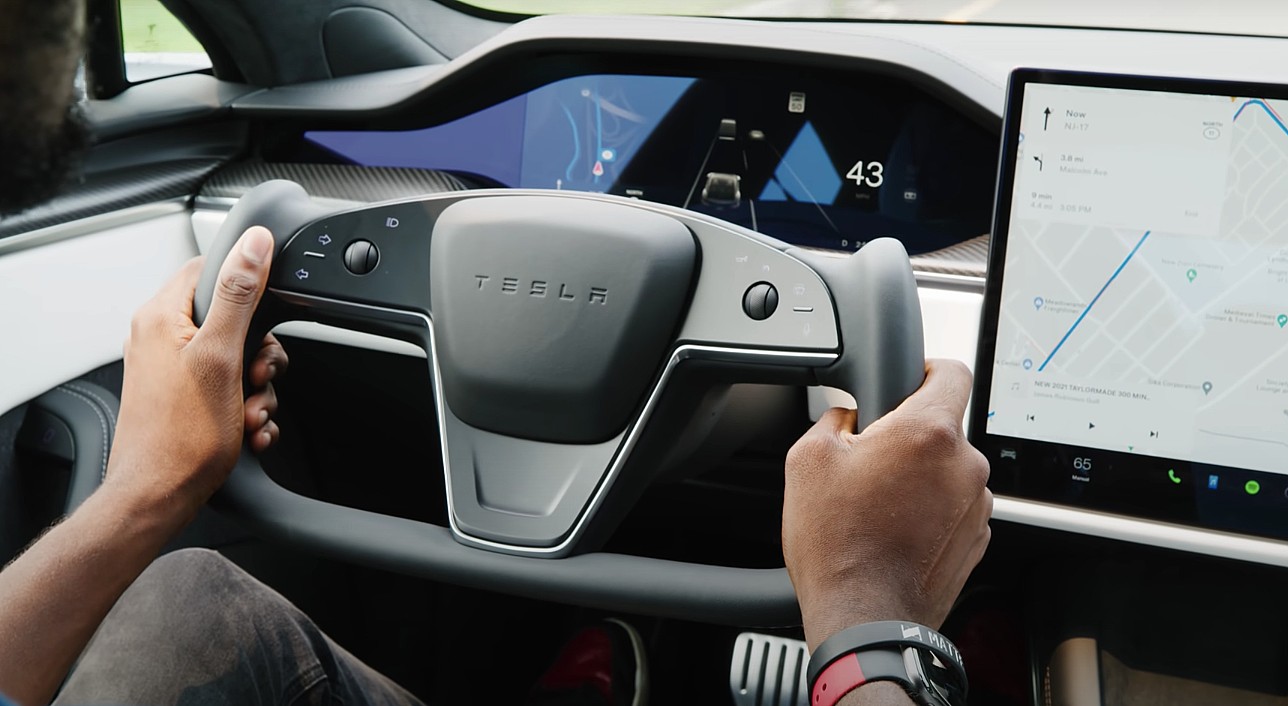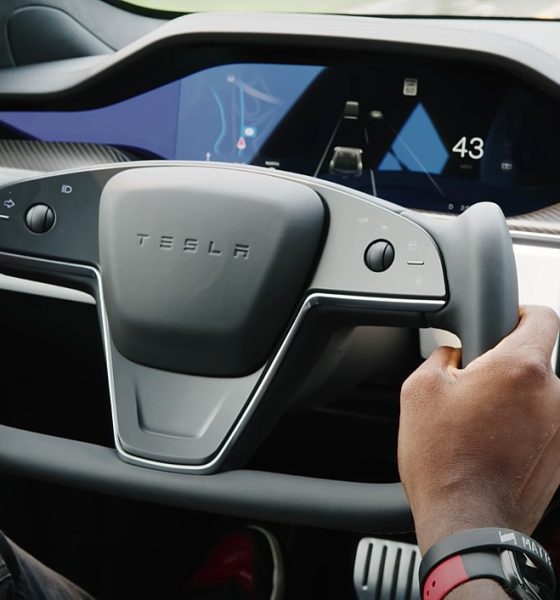

News
Tesla’s 20 million EV goal for 2030 can be equated to the Manhattan Project: expert
For the longest time, Tesla has played the role of a disruptor, a force in the auto industry that pushes other companies to change and acknowledge the legitimacy of battery electric vehicles. But with the company’s 20 million EV goal for 2030, Tesla is trying to go far beyond disruption — it’s trying to fundamentally remake the global auto industry and the battery sector at the same time.
If successful, Tesla could become the world’s largest company. Billionaire investor and longtime Tesla bull Ron Baron mentioned this recently when he noted that the only company that could probably follow the EV maker is Elon Musk’s private space firm, SpaceX. Selling 20 million vehicles in 2030 would also make Tesla an automaker that matches Toyota and Volkswagen’s sales today combined, holding about 20% of the global vehicle market.
Needless to say, Tesla’s goals are extremely ambitious. For the company to achieve this, Tesla should see a 14-fold increase over the estimated 1.4 million or so vehicles that it is hoping to sell this year. It will also cost hundreds of billions of dollars, as per a Reuters analysis of Tesla’s financial disclosures and forecasts on the electric vehicle sector as a whole.
Michael Tracy of The Agile Group, a manufacturing expert, noted that Tesla’s 20 million EV goal for 2030 is so ambitious, it could be equated to the Manhattan Project, the United States’ massive effort in the Second World War that paved the way to the creation of nuclear weapons. “I’d equate this with the Manhattan Project in World War Two,” Tracy said.
Tesla has been growing fast, but it will have to grow at an unprecedented rate in the coming years if it wishes to hit its 2030 target. Tesla would have to construct about seven or eight more Gigafactories every 12 months or so in the coming years. It would also need to secure about 30 times as much battery capacity to supply its operations. Reuters estimated that it would cost an estimated $400 billion over the next eight years to build Tesla’s manufacturing footprint across the globe and another $200 billion to build or purchase batteries.
Benchmark Mineral Intelligence, which tracks the worldwide EV battery segment, noted that Tesla would likely have to secure 2.0 million tons of lithium, 1.3 million tons of nickel, 0.2 million tons of cobalt, and 3.5 million tons of graphite to support its 20 million EV goal in 2030. This is about four times as much lithium and nickel, about twice as much cobalt, and seven times as much graphite as the entire electric vehicle segment is looking to consume this year.
Tesla has been busy pursuing its ambitious 2030 goal. Former Tesla executives interviewed by the publication noted that Tesla had started signing offtake agreements with miners and refiners over a decade ago. The former Tesla executives reportedly noted that the company currently has deals with over 20 materials suppliers across the globe.
While experts today have stated that the raw material capacity needed to support Tesla’s 20 million EV goal for 2030 does not exist for now, the electric vehicle maker has a reputation for having great foresight. It may seem inconceivable now, but Tesla was considered insane in the past when it decided to build Gigafactory Nevada to prepare for the Model 3’s ramp. Back then, experts also questioned whether such a massive investment was warranted because the demand for EVs was still uncertain. But as history would show, Tesla was eventually proven right.
Don’t hesitate to contact us with news tips. Just send a message to simon@teslarati.com to give us a heads up.

Elon Musk
Elon Musk’s X will start using a Tesla-like software update strategy
The initiative seems designed to accelerate updates to the social media platform, while maintaining maximum transparency.

Elon Musk’s social media platform X will adopt a Tesla-esque approach to software updates for its algorithm.
The initiative seems designed to accelerate updates to the social media platform, while maintaining maximum transparency.
X’s updates to its updates
As per Musk in a post on X, the social media company will be making a new algorithm to determine what organic and advertising posts are recommended to users. These updates would then be repeated every four weeks.
“We will make the new 𝕏 algorithm, including all code used to determine what organic and advertising posts are recommended to users, open source in 7 days. This will be repeated every 4 weeks, with comprehensive developer notes, to help you understand what changed,” Musk wrote in his post.
The initiative somewhat mirrors Tesla’s over-the-air update model, where vehicle software is regularly refined and pushed to users with detailed release notes. This should allow users to better understand the details of X’s every update and foster a healthy feedback loop for the social media platform.
xAI and X
X, formerly Twitter, has been acquired by Elon Musk’s artificial intelligence startup, xAI last year. Since then, xAI has seen a rapid rise in valuation. Following the company’s the company’s upsized $20 billion Series E funding round, estimates now suggest that xAI is worth tens about $230 to $235 billion. That’s several times larger than Tesla when Elon Musk received his controversial 2018 CEO Performance Award.
As per xAI, the Series E funding round attracted a diverse group of investors, including Valor Equity Partners, Stepstone Group, Fidelity Management & Research Company, Qatar Investment Authority, MGX, and Baron Capital Group, among others. Strategic partners NVIDIA and Cisco Investments also continued support for building the world’s largest GPU clusters.
News
Tesla FSD Supervised wins MotorTrend’s Best Driver Assistance Award
The decision marks a notable reversal for the publication from prior years, with judges citing major real-world improvements that pushed Tesla’s latest FSD software ahead of every competing ADAS system.

Tesla’s Full Self-Driving (Supervised) system has been named the best driver-assistance technology on the market, earning top honors at the 2026 MotorTrend Best Tech Awards.
The decision marks a notable reversal for the publication from prior years, with judges citing major real-world improvements that pushed Tesla’s latest FSD software ahead of every competing ADAS system. And it wasn’t even close.
MotorTrend reverses course
MotorTrend awarded Tesla FSD (Supervised) its 2026 Best Tech Driver Assistance title after extensive testing of the latest v14 software. The publication acknowledged that it had previously criticized earlier versions of FSD for erratic behavior and near-miss incidents, ultimately favoring rivals such as GM’s Super Cruise in earlier evaluations.
According to MotorTrend, the newest iteration of FSD resolved many of those shortcomings. Testers said v14 showed far smoother behavior in complex urban scenarios, including unprotected left turns, traffic circles, emergency vehicles, and dense city streets. While the system still requires constant driver supervision, judges concluded that no other advanced driver-assistance system currently matches its breadth of capability.
Unlike rival systems that rely on combinations of cameras, radar, lidar, and mapped highways, Tesla’s FSD operates using a camera-only approach and is capable of driving on city streets, rural roads, and freeways. MotorTrend stated that pure utility, the ability to handle nearly all road types, ultimately separated FSD from competitors like Ford BlueCruise, GM Super Cruise, and BMW’s Highway Assistant.
High cost and high capability
MotorTrend also addressed FSD’s pricing, which remains significantly higher than rival systems. Tesla currently charges $8,000 for a one-time purchase or $99 per month for a subscription, compared with far lower upfront and subscription costs from other automakers. The publication noted that the premium is justified given FSD’s unmatched scope and continuous software evolution.
Safety remained a central focus of the evaluation. While testers reported collision-free operation over thousands of miles, they noted ongoing concerns around FSD’s configurable driving modes, including options that allow aggressive driving and speeds beyond posted limits. MotorTrend emphasized that, like all Level 2 systems, FSD still depends on a fully attentive human driver at all times.
Despite those caveats, the publication concluded that Tesla’s rapid software progress fundamentally reshaped the competitive landscape. For drivers seeking the most capable hands-on driver-assistance system available today, MotorTrend concluded Tesla FSD (Supervised) now stands alone at the top.
News
Elon Musk’s Grokipedia surges to 5.6M articles, almost 79% of English Wikipedia
The explosive growth marks a major milestone for the AI-powered online encyclopedia, which was launched by Elon Musk’s xAI just months ago.

Elon Musk’s Grokipedia has grown to an impressive 5,615,201 articles as of today, closing in on 79% of the English Wikipedia’s current total of 7,119,376 articles.
The explosive growth marks a major milestone for the AI-powered online encyclopedia, which was launched by Elon Musk’s xAI just months ago. Needless to say, it would only be a matter of time before Grokipedia exceeds English Wikipedia in sheer volume.
Grokipedia’s rapid growth
xAI’s vision for Grokipedia emphasizes neutrality, while Grok’s reasoning capabilities allow for fast drafting and fact-checking. When Elon Musk announced the initiative in late September 2025, he noted that Grokipedia would be an improvement to Wikipedia because it would be designed to avoid bias.
At the time, Musk noted that Grokipedia “is a necessary step towards the xAI goal of understanding the Universe.”
Grokipedia was launched in late October, and while xAI was careful to list it only as Version 0.1 at the time, the online encyclopedia immediately earned praise. Wikipedia co-founder Larry Sanger highlighted the project’s innovative approach, noting how it leverages AI to fill knowledge gaps and enable rapid updates. Netizens also observed how Grokipedia tends to present articles in a more objective manner compared to Wikipedia, which is edited by humans.
Elon Musk’s ambitious plans
With 5,615,201 total articles, Grokipedia has now grown to almost 79% of English Wikipedia’s article base. This is incredibly quick, though Grokipedia remains text-only for now. xAI, for its part, has now updated the online encyclopedia’s iteration to v0.2.
Elon Musk has shared bold ideas for Grokipedia, including sending a record of the entire knowledge base to space as part of xAI’s mission to preserve and expand human understanding. At some point, Musk stated that Grokipedia will be renamed to Encyclopedia Galactica, and it will be sent to the cosmos.
“When Grokipedia is good enough (long way to go), we will change the name to Encyclopedia Galactica. It will be an open source distillation of all knowledge, including audio, images and video. Join xAI to help build the sci-fi version of the Library of Alexandria!” Musk wrote, adding in a later post that “Copies will be etched in stone and sent to the Moon, Mars and beyond. This time, it will not be lost.”








